#Marie of Blois
Explore tagged Tumblr posts
Text
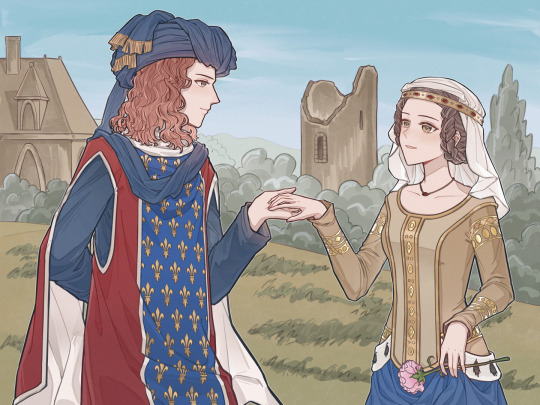
Thanks @hilda-dewitt for this great piece of work depicting Louis I of Anjou and Marie of Blois, great-grandparents of Margaret of Anjou. Louis I of Anjou was the founder of the Angevin cadet branch of the House of Valois, and Marie of Blois was the first of a series of powerful women in the House of Valois-Anjou.
I really found their story to be full of fun and drama. After King John II of France was taken prisoner in the Battle of Poitiers, Louis broke the Aragonese marriage contract arranged by his father to marry Marie, the daughter of one major claimant to the ducal throne of Brittany, neighboring his appanage of Anjou. His desire to meet his wife pushed him to end his hostage career in England prematurely on his own, and more or less led to the decision of John II to return to captivity, lol. While Marie's father fell in battle six months after John the Good's death in London, the couple remained close and intimate throughout their lives. Louis served as a leading military commander in his elder brother Charles V's reconquest of southwestern France during the second phase of the Hundred Years' War. He was also a loyal friend and protector of Bertrand du Guesclin, who fought for Marie's father before entering service for the Valois. However, due to his role in the 1378 tax revolts and his overambitious claim to the throne of Naples, Louis remained a controversial figure in France, and his past accomplishments were little appreciated. After Louis's death in the unsuccessful march to Naples, Marie continued their quest for the Neapolitan crown, and, after a tough fight against opposing claimants, secured for their seven-year-old son Louis II the County of Provence, which was in a personal union with the Kingdom of Naples. She acted as regent for Louis II during his minority, and arranged the marriage between him and Yolande of Aragon.
#Louis I of Anjou#Marie of Blois#hundred years war#medieval#fanart#historical fanart#french history#commission art#house of valois#margaret of anjou#Yolande of aragon
60 notes
·
View notes
Text
"Louis I of Anjou’s death in Bari on September 21, 1384, escalated tensions in Provence. The threat that France would absorb the county loomed; Charles VI and Jean, duke of Berry, courted the dissidents while offering to help Louis’s widow, Marie of Blois, conquer Naples.
Marie, however, a shrewd and able regent, was determined to protect her son’s [Louis II of Anjou's] rights in the county as well as in Italy. She reacted strongly and swiftly, moving into Provence and taking aggressive action against the rebels. She also hastened to have her son swear fealty to Clement VII for Johanna’s lands, establishing him as the late queen’s heir and securing Clement’s support. A second meeting of the Estates assured Marie of the high nobility and won several new communes for Louis II, while it also negotiated a twenty months’ truce between Marie and the Union of Aix, which had no wish to see the county under French dominion.
During the truce negotiated with the Union of Aix, Marie pressed her advantage. Arles reunited with the crown in November 1385, Brignoles in May 1386, and Sisteron in June 1386, isolating the Union. Although Margaret of Durazzo attempted to keep Charles’s death in February 1386 a secret, the news made its way to Provence, leading more communes to negotiate with Marie in the spring of 1386. Marie continued her diplomatic efforts into the autumn of 1387, achieving a peace accord with most of the communes in June of that year. Aix finally capitulated on September 17. Pockets of resistance remained: Nice continued to hold out, and the remaining Carlist communities fell under the control of Savoy in 1388. Despite her losses, however, Marie had won back most of the county, establishing a base of power for Louis II. She was free to turn her attention to Naples, which became her primary concern from early 1388."
— Elizabeth Casteen, From She-Wolf to Martyr: The Reign and Disputed Reputation of Johanna I of Naples
#I love her can't you tell?#marie of blois#italian history#louis I of anjou#french history#14th century#historicwomendaily#my post
15 notes
·
View notes
Text
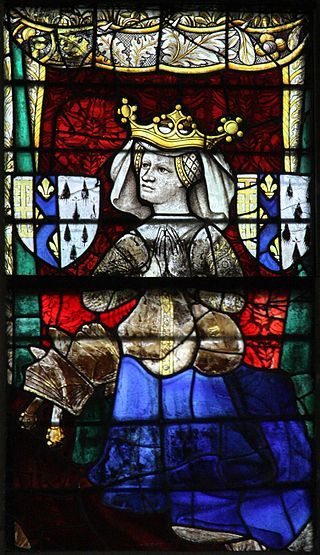
Marie of Blois (1345–1404) was a daughter of Joan of Penthièvre, Duchess of Brittany and Charles of Blois, Duke of Brittany. Through her marriage to Louis I, Duke of Anjou, she became Duchess of Anjou, Countess of Maine, Duchess of Touraine, titular Queen of Naples and Jerusalem and Countess of Provence.
3 notes
·
View notes
Text
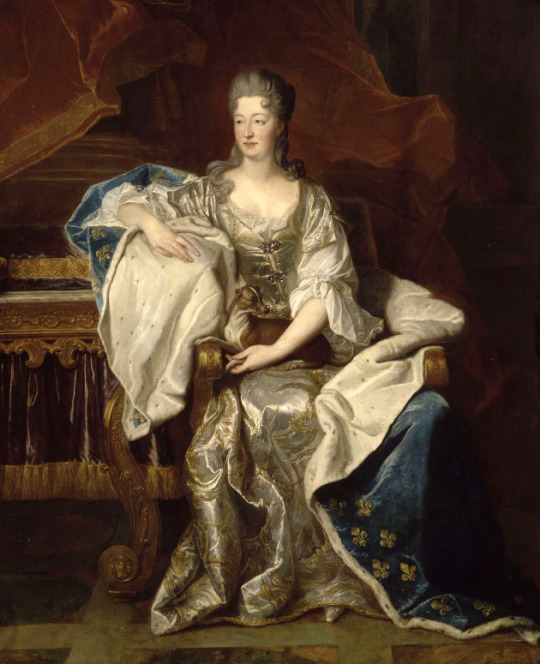
Marie-Anne de Bourbon (1666-1739). Atelier de Hyacinthe Rigaud.
#hyacinthe rigaud#royaume de france#maison de bourbon#marie anne de bourbon#mademoiselle de blois#blois#fils et filles de france#fille de france#royal bastards#fille légitimée#fils et filles de louis xiv#princesse de conti#bourbon conti#maison de conti#duchesse de La Vallière#duchesse de Vaujours#kingdom of france#house of bourbon
8 notes
·
View notes
Text
“I give myself to you, Mary, praying that you might give me to Jesus, so that he might give himself to me.”
—Jeanne Bloy, quoted in Léon Bloy, Four Years of Captivity in Cochons-sur-Marne
1 note
·
View note
Text
so i don’t understand what is *so* hard to get about the idea that rhaenyra being crowned as queen *peacefully* would’ve at least introduced the baby-step process that women can inherit the iron throne, even if it doesn’t automatically lead to absolute primogeniture and prompt benefits being established for -all- women.
book-wise we have one (ONLY one) inkling of how rhaenyra feels about the succession, and it’s that she doesn’t wish to alienate any more allies than she already had:


show-wise we have a vague and contradictory line of jace and baela’s sons inheriting the iron throne followed by luke and rhaena’s children inheriting the driftwood throne, which just seems like an inconsistency in the writer’s room, but why is that *such* an issue for those that support aegon’s claim to begin with? rhaenyra only has sons (biologically) at this point, so we really don’t know whether or not she would’ve named a daughter as her heir over a son, but this thought process derives from real history. eventually female heirs were allowed in certain circumstances but male children were *always* preferred (until recently). this still doesn’t change what her reign would’ve entailed had there not been war. rhaenyra is allowed to fight for the right her father granted onto her when she was 8 years old, aegon was not entitled to it simply because he was born with a penis and his mother raised him to believe that made him special.
jeyne arryn, one of her staunchest allies, point blank states what will happen to women heirs and ladies in their own right if the greens are allowed to repudiate the succession, because it’s something she -personally- had gone through:
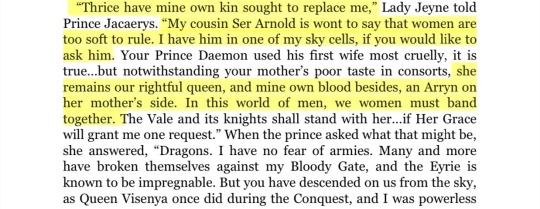
“in this world of men, we women must band together,” the green council states that they cannot rely on the eyrie for support due to is presently being ruled by a WOMAN. they knew what this would mean for women moving forward.
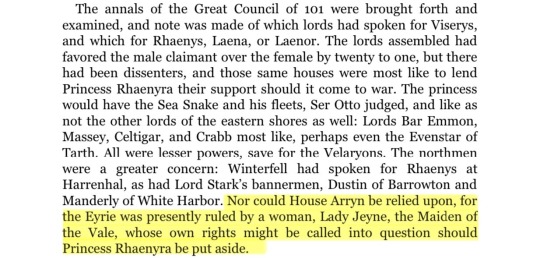
if we were to look into the history of english monarchs the first (official) queen regnant of england was mary i, who ruled for five years, and didn’t make any changes to the rules of succession during her reign (any that involved gender, any battles she faced mostly had to do with religion). she was followed by her sister elizabeth i, who ruled for 45 years, and made no changes to the rules of succession. both of whom ascended as queen because there were no male relatives alive at the time, but each obviously proved that women were just as capable of men ruling, releasing at least some of the stigma surrounding that subject during their time alive. it wasn’t even until recently, during the reign of elizabeth ii (in 2013, specifically), that absolute primogeniture was enacted into law, ending the system of male-preference cognitive primogeniture. mary became queen in october of 1553, so it took 460 years for this change to occur.
rhaenyra is based off empress matilda, daughter of henry i, who would’ve been the first queen regnant of england had she not been challenged and deposed by her cousin, stephen of blois, in a war known as the anarchy; with it ultimately ending when a peace treaty was signed by both stephen and matilda, with her son henry ii named as stephen’s successor upon his death (which happened a year later). this war began in 1135, which was 878 years before the succession was formally changed and 418 years before england would actually see a queen on the throne. this is just to put it into perspective how one queen is not going to immediately enact change for the betterment of all women whilst attempting to rule an age-old abhorrent system, but saying that they had no bearing on succession laws and gender equality moving forward is wild.
not only did rhaenyra only reign for six months, she was in the middle of a civil war that had resulted in the deaths of four of her children (as far as she knew) at that point. among that the treasury had been depleted and sent to green loyalists, so she was taking over a country with virtually no money at hand. her reign was damned from the start, and her near broken mental state led her to make some bad decisions. from the beginning of her heir ship she was looked down upon for being a woman; her stepmother spread vile rumors about her virginity when was in her early teens, her sworn shield groomed and took advantage of her, her siblings were raised to hate her and view her as a threat to THEIR birthright and lives, her father was nigh on useless in protecting her against any of this due to his pacifist and pushover nature. she was usurped because she was a woman, and ultimately killed because she was a woman. denying the tragedy of her life is refusing to understand the deeper components of the story being told.
if women aren’t even able to hold offices of high power how is anything supposed to change for those in even worse circumstances? women didn’t gain semi equal rights by being silent and subservient to the men around them, they gained them by fighting back against the status quo; by marching, lobbying their politicians, lecturing those willing and unwilling to listen to their plight, causing civil disobedience, etc. we shouldn’t condemn those that do not have the will nor the ability to participate in these events, but refusing to understand their opposites and overtly criticizing how imperfect they are or blaming them for their suffering is not the way to go.
once again, rhaenyra is not a feminist, but she should be seen as a proto-feminist figure by us, the audience, for her will to stake her claim as the first woman to sit the iron throne. her usurpation and subsequent murder leads to the death of all dragons, a catastrophic consequence considering her parallels to the amethyst empress and the dire stakes at hand in regard to the second long night.
#house of the dragon#hotd#fire and blood#rhaenyra targaryen#pro rhaenyra targaryen#team black#pro team black#anti team green#anti team green stans#real feminists do NOT support the patriarchy just bc it’s headed by misogynistic white woman who cries prettily#and thinks she’s the only exception to the ‘no women in power rule’ AND a violent misogynistic rapist as king#i would think this should be obvious#but hotd has allowed some truly braindead takes to spread#all by sex obsessed airheads that can’t differentiate attractive actors from the characters they play#if you see any mistakes in this NO YOU DIDNT
118 notes
·
View notes
Text
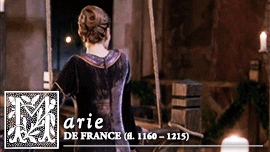

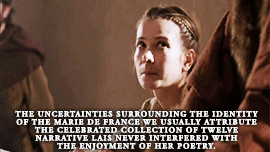
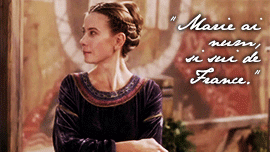
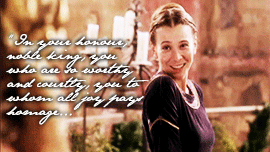
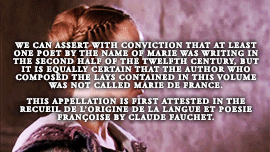
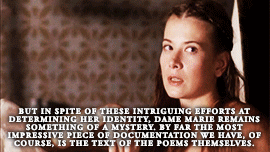
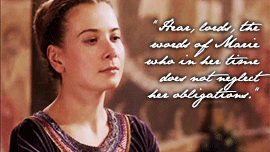

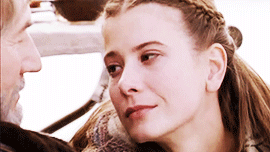
Medieval Women Week || Favorite woman writer ↬ Marie de France
Who was this versatile author, the first woman of her times to have written successfully in the vernacular? She was definitely not Marie de Champagne, daughter of Eleanor of Aquitaine and patroness of Chrétien de Troyes, as Winkler suggested. A tempting, but by no means fully convincing, identification is with Marie, abbess of Shaftesbury in Dorset, illegitimate daughter of Geoffrey Plantagenet and half-sister to Henry II. … A claim has been made, albeit somewhat thin, for Mary, abbess of Reading. This abbey was well known as a centre of literary activity and had in its possession the Harley manuscript containing, as we have seen, both the Fables and the Lais. There is no clear-cut reason why either work could not have been written by an abbess or a nun, and there is some slight evidence of experience of monastic life in Le Fresne, Yonec and Eliduc. But the prominence of the motif of adultery in the Lais (see also fables 44 and 45), Marie’s attitude towards the dissolution of marriage in Le Fresne and Eliduc, and her evident interest in the chivalric life suggest that these love poems were not written by someone steeped in ecclesiastical ideology. … Marie de France was certainly an educated lady of good family, who knew Latin well enough to have contemplated translating a Latin work into French (Lais, Prologue, vv. 28–32) and to have done so in the case of the Espurgatoire. She was obviously a good linguist and acquired a sound knowledge of English before translating the fables. She was also fully conversant with the life and aspirations of the nobility of her time. Her education could well have been obtained in a convent and her knowledge of court life from her upbringing and personal experiences in England. Was she Marie, the eighth child of Waleran de Meulan (also called Waleran de Beaumont), a member of one of the greatest of the Norman houses? Waleran’s fief was in the French Vexin, which would tally with Marie’s statement that she comes from France and explain her evident local knowledge of the town of Pitres in the Norman Vexin… Marie de Meulan married Hugh Talbot, baron of Cleuville, owner of lands in Herefordshire and Buckinghamshire, as well as in Normandy, and a member of a family prominent in several English counties including Devonshire, Gloucestershire and Kent. Marie’s father is an interesting figure – a loyal and courageous soldier, but also a well-educated man who may have written Latin verse. Moreover, several of the manuscripts of the Historia Regum Britanniae of Geoffrey of Monmouth are dedicated to him. It is tempting to think that his daughter may have known William of Gloucester, a possible Count William, as his father was also one of Geoffrey’s dedicatees. Marie de Meulan may, however, have been too young to be Marie de France, as her birth seems to date from the 1140s, perhaps as late as 1150. The most recent identification has been as Marie, countess of Boulogne after 1154, daughter of Stephen of Blois (King of England, 1135–54) and of Matilda of Boulogne. Educated in a convent, Marie de Boulogne became abbess of Romsey in Hampshire, but was removed from her convent by Henry II, who wanted to keep Boulogne in his sway. She was married off to Matthew of Flanders and thus became the sister-in-law of Hervé II, son of Guiomar of Léon... Eventually, at some time between 1168 and 1180, Marie de Boulogne returned to a convent, perhaps that of Sainte Austreberthe at Montreuil-sur-Mer in her own county. Her Count William could have been William of Mandeville, a crusade companion of Philip of Flanders, her husband’s brother. The ‘noble king’ would probably have been the Young King, as Philip and Matthew, originally supporters of Henry II, changed sides in 1173. Marie herself may have already been a supporter of the Young King, as in 1168 she sent Louis clandestine information about the secret negotiations between Henry and the Emperor Frederick. — The Lais of Marie de France translated with an introduction by Glyn S. Burgess and Keith Busby
#medievalwomenweek#marie de france#english history#french history#european history#women's history#medieval#history#nanshe's graphics
35 notes
·
View notes
Text
Frustration when I watched a television show about the Overseas Departments and Haiti during the period of the re-establishment of slavery and in general.

The siege of the Crête at Pierrot in 1802, by A. Raffet, engraving Hébert, 1839
Warning: There are many atrocities I will talk about when we dive into the details of the Haitian Revolution and torture in the reedit in the end . So, don’t read if you’re not up for it.
Completely by chance, I caught the second half of the show "Toussaint Louverture" (though I skipped some parts, I admit) presented by Stéphane in his show "Secrets d’Histoire," which I would qualify as mediocre. However, I was surprised to see that this show, which has always been lenient towards Bonaparte and Louis XVI, finally addresses the horrible re-establishment of slavery and recalls that the second and final abolition of slavery in 1848 was unsatisfactory because financial compensation was given to the colonists, but nothing to the former slaves. The one in 1794 seemed better. The participants of the show indeed say that it was a grave mistake to re-establish slavery, both morally and strategically regarding Haiti. I don't feel they explained how disastrous the consequences were, like how these laws removed brilliant officers from the military, such as Louis Delgrès (although mentioned in the show) or Alexandre Dumas (not to mention many former slaves who served in the military or fought like the group to which belonged Flore Blois Gaillard, who allied with the French revolutionaries against the British forces). This was a severe blow to the army, especially with the laws we could call racial against Black people (though I hesitate to use this term because I'm not sure if the word racist was defined as we understand it today). It was a great blunder—if Bonaparte hadn't had the (stupid) idea to re-establish slavery, perhaps the Overseas Departments wouldn't have fallen under British influence (as for Haiti, I think it would have become independent even without the re-establishment of slavery, and France and Haiti could have been solid allies, but it would have been much less violent with fewer French and Haitian losses). All these wars cost enormous amounts of money, and I believe he wouldn’t have sold Louisiana (frankly, he surely had good reasons, but can you imagine the French revolutionaries, especially those from 1792-1794, even in their worst moments, trying to sell a territory, at least the majority of the Convention? I can't). Moreover, there is no mention of the horrible deportations endured by Guadeloupeans and Haitians to Corsica, whether men, women, or children, under atrocious conditions. The most famous victim is the deputy Jean Louis Annecy (although very forgotten), who died on the island of Elba in 1807.
As usual, revolutionary women are forgotten. There is only a mention of Rosalie, alias Solitude, but there were many who participated in the fight, including Sanité Belair, who was executed by firing squad with her husband, Marie Claire Bonheur, the future Empress of Haiti, Victoria Montou, Dédée Bazile, Cécile Fatiman, Marthe Rose Toto from French Guiana, etc. The list is very long.
Finally, I don't like this whitewashing of Charles Leclerc (they do say that Rochambeau was terrible, at least, but since Leclerc was Bonaparte’s brother-in-law, he surely received some favorable treatment in this show). Here is an excerpt from the beginning of his horrors: "The majority of the deportees were concentrated in Corsica and the island of Elba, where they were used as labor for road construction and fortification restoration starting with the former Black soldiers" (text excerpt from "La guerre des Couleurs" of Pierre Branda and Thierry Lentz) . There was authorization to condemn Black people based on mere suspicion. Moreover, here is a letter Leclerc sent to his brother-in-law Napoleon Bonaparte: "Here is my opinion on this country. We must destroy all the Black people in the mountains, men and women, keep only the children under 12 years old, destroy half of those in the plains, and not leave a single colored man who has worn an epaulette in the colony." To think that I found the orders from the Convention in 1793-1794 frightening because they were ambiguous... Well, another reason why I find Bonaparte much more terrifying than them (already, the torture practiced by the police under Fouché in 1801 was appalling when he allowed it, the deportation without trial of many Jacobins, some of whom died, etc.), it reinforced my belief that he was much worse than the Committee of Public Safety in 1794, who nevertheless committed unforgivable acts in wartime under the infernal situation of internal-external civil war. Leclerc started the drownings in October 1802: it didn't matter whether the victims were civilians or soldiers; they were put on boats that were sunk. This strongly recalls the horrors committed by Carrier. According to Marlene L. Daut, the horrors were such that there were many desertions among French soldiers, which must not have been an easy situation for them because they could be shot for desertion and, even if they survived, forced to avoid returning home to avoid trouble with Napoleonic justice.
Leclerc (and by extension, Bonaparte) fell into the trap that some fighters, victims of an invasion or imminent invasion, have used throughout history, which seems quite old: pretending to ally with their adversaries to buy time, even if it means sacrificing their own to better fight the enemy again (and they certainly don't reach the only ones using this technique). This is what happened with Dessalines: the show doesn’t explain the armed resistance led by the Bélair couple against Leclerc, where they temporarily won victories. However, some believe this uprising might have been premature, although the insurgents weakened Leclerc with certain victories, and consequently, Dessalines allowed Charles and Sanité Bélair to be sacrificed. To be fair, the show I mentioned briefly explains that Henry Christophe and Dessalines did not betray Toussaint; they just wanted to buy time, but there is no mention of the Bélair couple. According to historians Pierre Branda and Thierry Lentz, Dessalines killed two birds with one stone by eliminating a potential rival in the person of Charles Bélair and to lull Leclerc's distrust to better attack when the time comes. In any case, by buying time, they were able to achieve better victories against Leclerc (who surely thought that by compromising Dessalines in the eyes of Black people, the insurgents would no longer dare to fight with him, but he was wrong) and later Rochambeau. Rochambeau continued by increasing atrocities, notably by releasing dogs on Black people and continuing to practice torture. There are allegations that Rochambeau locked Black people in holds and activated sulfur so they would die of asphyxiation. Thierry Lentz and Pierre Branda think it is not impossible that this happened. Bernard Gainot cites Jules Chanlatte from his work "Histoire de la catastrophe de Saint-Domingue" and published by a former sailor, Jean-Baptiste Bouvet de Cissé, in 1824: "Instead of valve boats, another type was invented, where victims of both sexes, piled on top of each other, expired suffocated by sulfur fumes." Whatever the case, the insurgents militarily defeated Rochambeau and the French troops, and their final victory was the Battle of Vertières in November 1803. Following this, Haiti's independence was proclaimed.
Where I totally disapprove is when, in order to try to limit the horrors that the Blacks people have suffered, they explain their reprisals, especially with the horrible massacre of the Whites people in 1804. I have already said in a post that massacre it is absolutely condemnable and atrocious . But imagine the horror of a little less than half of the Haitian population massacred in atrocious suffering, some betrayed by France while they had fought for them, others deported in atrocious conditions and some will never see their home again. I think that if their adversaries who oppressed them and those who applauded them had suffered a quarter of an eighth of the horrors that the Haitians suffered, the carnage would have been even more terrible. I do not want to exonerate the Haitians who took part in the massacre of 1804 from the responsibility but if Bonaparte had not approved such cruel orders (and he is the number 1 person responsible for this carnage), Whites people would not have been killed at least not in large numbers. The historian Thomas Madiou, said "Is it surprising that blacks and men of color used reprisals against whites?" And in any case nothing excuses the attitude of Bonaparte, Rochambeau or Leclerc. In my eyes they behaved like Turreau and Carrier. If we try to exonerate Bonaparte and his clique responsible for these massacres by highlighting the atrocities on the other side, it is a call to also exonerate horrible people like Carrier and Turreau by saying that the Vendéens committed massacre too.
In addition, the show ignored the many Haitians who protected white people from this massacre (Including Marie Claire Bonheur, wife of Dessalines, who nevertheless ordered the massacre I mentioned here: https://www.tumblr.com/nesiacha/758334606594523136/166-years-ago-empress-marie-claire-bonheur-of?source=share) and didn't said that the Polish legionnaires who were sent by Bonaparte to repress them were touched by the horrors that the Blacks suffered and many of them deserted to fight alongside the former slaves (as a form of recognition, the survivors were given Haitian nationality) were spared just like the Germans who had not participated in the slave trade ( but on the second point maybe I am wrong). For my part Rochambeau, Leclerc, Carrier and Turreau are to be put in the same bag concerning their atrocities when they were sent on a mission. Too bad Turreau and Rochambeau did not pay for their atrocities (some say that the fact that Leclerc died of yellow fever is enough karma and Carrier was guillotined and I do not pity him at all)
Finally, this isn't in the show, but I don't like when people say that Bonaparte was "a man of his time" to excuse his actions regarding slavery. No, he reinstated it, which is even worse. Sonthonax, Abbé Grégoire, Jean-Paul Marat, Pierre Gaspard Chaumette, Olympe de Gouges, and many others were also from the same era as Bonaparte and were opposed to slavery. The re-establishment of slavery shocked many French people, and a white man named Monnereau, under the orders of Delgrès, was hanged in Guadeloupe because he rose up against the re-establishment of slavery and drafted Louis Delgrès' last manifesto. While Bonaparte was reinstating slavery, a white man gave his life for the fight against it (and there must have been many examples like Monnereau). So, this argument to whitewash Napoleon doesn't hold up.
P.S.: I first found the information about asphyxiation from Claude Ribbe. However, even as a convinced, even a person like me petty, anti-Napoleon person ( and a bad faith person I admit it), I find him not very credible. Comparing Napoleon to Hitler is one of the most absurd things I ever heard. That's why I'm more cautious about this statement.
My sources for this post are: Bernard Gainot Pierre Branda, Thierry Lentz, "La guerre des couleurs"
#haiti#haitian revolution#napoleon#napoleonic era#rochambeau#charles leclerc#vendée#carrier#Turreau#guadeloupe#slavery
30 notes
·
View notes
Text


James V, King of Scots married Madeleine de Valois on January 1st 1537.
Madeleine of Valois was a French Princess who played a brief but significant role in European history as the first wife of James V of Scotland and, for a short time, the Queen of Scotland.
Madeleine’s poor health meant she died only six months after their wedding day – her short time as Consort led her to receive the nickname the ‘Summer Queen’ of Scots. Despite her short reign and tragically young death, Madeleine left both a direct and indirectly lasting impact on the tumultuous political landscape of Scotland.
Madeleine of Valois was the fifth child and third daughter of King Francis I and Claude, Duchess of Brittany.
She was born at the Château de Saint-Germain-en-Laye in France on 10 August 1520. Frail since birth, Madeleine was raised in the mild climate of the Loire Valley region to protect her from the cold.
When Madeleine was 3 years old, her mother died, and she, along with her younger sister Marguerite, was raised by their paternal aunt, Marguerite of Navarre. However, after their father remarried Eleanor of Austria, Madeleine became part of her household.
By the age of 16, Madeleine had developed tuberculosis, the same illness that likely claimed her mother’s life.
Madeleine’s marriage to James V was a result of diplomatic alliances between the Valois and Stuart dynasties.
The Treaty of Rouen, signed three years before Madeleine’s birth, aimed to strengthen the ‘Auld Alliance’ between France and Scotland after Scotland’s shattering defeat by England at the Battle of Flodden. One provision of the treaty was the marriage of a French princess to the Scottish king. King James V was only 5 years old at the time of the Treaty, thus negotiations on the marriage did not begin until 1530.
In April 1530, John Stewart, Duke of Albany, was appointed commissioner to finalise the royal marriage between James V and Madeleine – the French King Francis I’s eldest living daughter. However, due to Madeleine’s poor health, Francis proposed an alternative French bride, Mary of Bourbon, from his extended family, who was to be given a dowry as if she were the French king’s daughter.
James V agreed to marry Mary, and travelled to France in 1536 to meet her. However, upon his arrival, Mary didn’t appeal to him and instead he became enamoured with Madeleine, promptly asking her father Francis I for her hand in marriage. Initially, Francis I refused, fearing that Scotland’s climate would worsen Madeleine’s fragile health.
Smitten by 16 year old Madeleine’s delicate beauty, James V continued to press Francis I to permit the marriage. Madeleine also made her desire to marry James very obvious, thus despite his reservations, Francis I reluctantly granted them permission. The marriage contract was made at Blois, where Madeleine renounced her claims to the French throne, and Francis I provided a substantial dowry.
James V and Madeleine were married on 1 January 1537 at Notre Dane Cathedral in Paris – Madeleine was 16 and James was 30. The union was celebrated with four months of festivities, strengthening the bond between France and Scotland and fulfilling the terms of the Treaty of Rouen. Due to Madeleine’s health, their journey to Scotland was delayed until spring.
James and Madeleine eventually sailed for Scotland, arriving on 19 May 1537, yet by this time, Madeleine’s health had deteriorated further, and she was very unwell when the royal couple landed at Leith. Despite this, Madeleine is said to have kissed the ground upon arriving in her husband’s kingdom.
In preparation for her arrival, James had ordered improvements to Falkland Palace and the Chapel Royal, and was also in the process of building new tennis courts, and had added a French-style tower to the Palace of Holyrood House.
However, Madeleine fell seriously ill shortly after arriving in Scotland, possibly due to tuberculosis. She was bedridden and unable to fullfill her role as queen consort. Despite her illness, Madeleine’s presence brought a touch of French culture and refinement – known for her beauty, grace, and intelligence, Madeleine quickly became beloved by the Scottish court.
Although expressing some improvement in a letter to her father from Edinburgh on 8 June 1537, James V was concerned enough to also write to him requesting the physician Master Francisco to be sent. Madeleine later wrote that Francisco would only be needed to perfect her cure.
Plans were underway for Madeleine’s coronation as Queen of Scotland, yet her health continued to decline. A month later, she died of tuberculosis in her husband’s arms on 7 July 1537 at Holyrood Palace, aged 16 – just 6 months and 7 days after their wedding. She was interred in the Royal Chapel at Holyrood Abbey in Edinburgh, next to King James II of Scotland.
Her death left James V devastated, and plunged Scotland into mourning.
14 notes
·
View notes
Text

From Eleanor of Aquitaine 's letters to Celestine III. Reading this paper analyzing the literary constructions and tropes she (or at least, her scribe Peter of Blois) utilizes rhetorically to try to persuade the Pope. It's about playing into the expectations and roles both of the "passive" grieving mother but also referencing the active Mary-As-Intercessor to solve her son's plight.
Also the Richard babyboyification is great in this. I get the rhetorical reason but also this is how I feel all the time

Article is "Motherly Devotion and Fatherly Obligation: Eleanor of Aquitaine’s Letters to Pope Celestine III" by Rachel F. Stapleton.
#richard the lionheart#eleanor of aquitaine#alienor d'aquitaine#12th century#Pope Celestine III#history stuffs#the Plantagenets#angevin empire
13 notes
·
View notes
Note
The Dance isn’t supposed to be the War of Roses. It’s clear as day that Rhaenyra is Empress Matilda and Aegon II is Stephen of Blois.
Jaehaera NEVER should have married Aegon III if we care about historical parallels at all. Stephen’s daughter, Mary I Countess of Boulogne, was abducted by her distant cousin and forced into marriage, became an abbess, lived until 46 years old, had daughters and multiple descendants. Mary and Henry II (Matilda’s son and Stephen’s successor) never married each other despite both of them being around the same age and being single when Stephen ended up recognising Henry as his adoptive son and named him heir.
Aegon III doesn’t deserve to be tied to the daughter of his mother’s killer, but if I was TG, I wouldn’t want Jaehaera to be tied to the son of the man who ordered B&C.
I write about the War of Roses v The Anarchy used in F&B HERE.
Instead of the Starks vs Lannisters the current ASoIaF Westerosi war is losely based on, we have branches of the same family fight each other.
Elizabeth York, Henry VII (Tudor)'s wife and Edward IV's daughter, can be said to be a Jaehaera stand-in of sorts merely for being the daughter of the (York/green) branch of the Plantagenets/Targaryens the other branch (Lancaster/black) side was fighting against. Despite Corlys defecting after the Seed's imprisonment, Daenaera isn't a daughter--direct or indirect--of the enemy the blacks were fighting. Thus the Dance is lightly based off of the Roses war in those ways. So I can see why people expect it to follow a lot more traits as that war & its ending. However, as I said in that linked post above, there are important differences. One especially where Elizabeth's family members weren't as intimately violent against Henry's specifically because Henry came from an even smaller branch of the Lancaster branch of the Plantagenets.
#asoiaf asks to me#english history#european history#war of the roses#the anarchy#asoiaf war#jaehaera targaryen#fiction vs reality#henry vii#elizabeth of york#hotd#fire and blood#asoiaf
10 notes
·
View notes
Text
They cancelled The Serpent Queen and I am so fucking mad!!
I'm french and guess where do I live? In the Loire Valley!! My hometown, Vendôme, is where The House of Bourbon (the one we see in the show) is from. Their full name is actually de Bourdon-Vendôme, because there are three different branches and if we only mention "Bourbon", it's kind of confusing because we don't know which branch we speak of and Bourbon-Vendôme is the one Henri IV is from. Which means, the character that we see in the show lived in the castle located next to my elementary school! I was young but I can still see and hear my teacher telling my class "This castle next to us was a big deal.". Henri IV didn't live here but he came a few times, especially when his mother, Jeanne d'Albret, died and was buried here (along with Antoine and their first born son (and Louis, Antoine's brother)). So when Jeanne died in the show, in the story, they technically should have been in my hometown (and Antoine and Louis should have been already dead lol). Same as when Antoine and Louis went back home to their dads. François I, François II, Marie Stuart, Charles IX and Catherine came here. Sadly, the castle is just ruins now... But it makes me sad that they never mentioned the name of the town once. Even Reign mentioned it. I mean, everyone knows that Reign was more fiction than facts but still, they mentioned Vendôme in one of the latest episodes of the show and it's still one of my proudest moment 🥹
Since I live in Vendôme, it means that I live 30 min away from le Château de Chambord, where they filmed most of the show. I love going there whenever I can but sadly, I never got the chance to go there when they were filming... 💔 It was weird and funny to see how they edited the outsides of the castle. Some editing didn't make any sense but I get it. Also, the big gardens are from a completely different castle located in Villandry. So it was weird to see Chambord edited in the background. And it didn't make any sense when we would see Chambord fully and the gardens weren't there, haha.
Also, le Château d'Amboise was used two times and they kinda disrespected it 😅 I'm not entirely serious when I say this but I kinda I am. The first time is in the season one finale, when Mary "arrives" in Scotland. The second that I saw the location I said "Oh, Amboise" and then I saw the ocean next to it and realised that it was supposed to be Scotland 😭 The second time was in season two when Catherine visits Diane (who is still pretty young and most importantly, miraculously still alive in 1572 😭). When Diane and Catherine talk we discover that they are in "Anet" (where she died in 1566). I was so happy when they mentioned where they were in the story but I was like "but, but, it's Amboise, guys 😭". It's funny and confusing for me because I know those castles but it's perfectly fine for an audience who has no clue. Also, le Château d'Anet is a private property, so I don't know if they would have allowed the show to come and filmed there, but also I've seen a documentary a few months ago and the owner seems very sweet, so I don't know. They also used Amboise, the town, to be Paris, where Catherine's brother was supposed to build le Palais des Tuileries.
And last but not least, I wanna talk about Blois (20 min away from me, next to Chambord) Oooh, Blois is probably my biggest heartbreak from that show. In season one, it made sense to be in Chambord because this castle was François I's baby but he lived there for only a month. Henri II didn't live there but kept the constructions going. When Henri II died, François II didn't live there. Charles IX didn't live there either but just like his father before him, he kept the constructions going and consolidated it. Henri III and Henri IV didn't live there and didn't do anything to it (it's such an Anjou and Henri behavior if you ask me haha). But if Henri II, François II, Charles IX and Henri III didn't live there, then where did they live, you ask?! Well, they lived in BLOIS. Which means that the whole show should have been happening in le Château de Blois, not Chambord. Y'all have no idea how excited I was when I heard that season 2 was filming in Blois. I thought, finally, they are going to aknowledge the most important castle of the Valois! I mean they actually all lived there and this is where Catherine died!! When I say that that castle is important to the Valois' story, it's because it is. Do I need to tell you how disappointed I was when I saw season 2 last week? A) I was expecting multiple scenes in the castle and well, that didn't happen. B) I had to wait the very last episode to see what they filmed there. C) THEY DIDN'T EVEN FILMED IN THE CASTLE!!! We see all the Protestants walking across the bridge, we see a few streets that I'm not even sure if it's actually Blois and then we see the castle, in the background, behind all the protestants who are looking at a cathedral that is not even located there. THEY EDITED THE CATHEDRAL OF TOURS IN BLOIS 😭 It's not fair. Honestly, all the editing stuff didn't really bother me. I understand that they did whatever they needed to for the aesthetic of the show. But not mentioning once the name of the town that was important to the true Valois Kings and Queens is something that I truly don't understand.
The show is about the French history, is filmed in France and guess what? We had NO WHERE TO WATCH IT IN FRANCE. The show arrived like a week ago on Max and it's been n°5 in the top 10 since then. French people want to see their country in a show and support it, we have the proof and THEY CANCEL IT?! I am so upset. They could have give it a third and last season to wrap it up. Season 2 was so much better than season 1. The Valois siblings did bring so much more depth, especially Anjou.
I CAN'T BELIEVE THAT I'M LOSING KING ANJOU. The potential that he had was insane.
Okay, I'm gonna shut up now and cry about it 😭
11 notes
·
View notes
Text
Marie of Blois and Louis II of Anjou, building on a foundation laid by Louis I and Clement VII, refashioned [Johanna I of Naples] as the founder of their new dynasty. They deliberately obscured their distant kinship to her, Marie and Louis I both depicting themselves as her loyal children. In her efforts to secure Provence for her son, Marie elaborated on this kinship, obscuring what was merely a legal relationship beneath her self-identification as Johanna’s “natural” daughter. In so doing, she played on the representation of Charles of Durazzo as a matricide: His behavior was unnatural, making him an unnatural son, while her devotion transformed her into a natural daughter. The word “natural” was thus polysemous, employed to mean both that Marie was Johanna’s biological daughter and that her behavior was appropriate while Charles’s was inhuman, unnatural. She deployed the emotional language of kinship to depict herself as a fitting successor to the murdered queen, whose virtue she enhanced and whose history she ignored. Charles, through his faithlessness, had forfeited any rights he might have had to Johanna’s throne, while Marie—the representative of Johanna’s designated heir and her faithful daughter—earned the right to it through her love and outraged grief. At the same time, she asserted her right to be Provence’s regent, representing the relationship between her family and Johanna as transcending legal nicety, binding them together in a spiritual kinship that obliterated any doubt as to the second Angevin line’s legitimacy.
— Elizabeth Casteen, From She-Wolf to Martyr: The Reign and Disputed Reputation of Johanna I of Naples
#Marie was an A+ propagandist lol#gotta love how she went out of her way to defend the claims of two ruling women (her mother and Johanna)#yes the latter was clearly for Marie and her own family's political benefit but still#Marie of Blois#Johanna I of Naples#historicwomendaily#italian history#14th century#my post
12 notes
·
View notes
Text
so there are quite a few ways to refer to monarchs, right? those include:
regnal number (james iiiii, edward lxix, and so on)
surnames, like stewart or plantagenet
dynastic names, or at least what we people of the present have retroactively made into dynastic names, like tudor or plantagenet (plantagenet was only used as a surname by the plantagenets for the last five minutes of its rule)
epithets, like richard the lionheart, alfred the great, cnut the great, bloody mary, and edward the average, except not edward the average
locative bynames (bynames essentially being the predecessor to surnames and denoting a specific characteristic of a person; very close to epithets in some scenarios, but essentially nicknames), like edward of caernarfon or edward of windsor. these don't get used much by monarchs, as they tend to be dropped in favour of a regnal number. the most famous example of this is probably stephen of blois
patronymics... very rarely. harold godwinson is the only case of this i can think of
occasionally, titles - some kings were not born heir to the throne, and as such are sometimes known as james, duke of york, or henry, earl of richmond, especially when discussing their pre-accession lives
and nicknames! epithets tend to be a bit more lofty than these, which are usually boring french descriptors - william rufus, henry beauclerc and henry curtmantle are the only real examples i can think of. technically, epithets are the same thing, but curtmantle is far too boring to be considered an epithet in good faith, if you ask me
why do i list all these? because they make referring to a monarch a lot easier. one king, rather irritatingly, defies most of these descriptors: king john. on his own wikipedia page, he's called "john, king of england." it's not that he didn't have a byname - he did: john lackland. but if you're trying to discuss him without insulting him all the way through, it's not very appropriate. he doesn't have a surname, because john plantagenet a) wasn't used and b) sounds awful. he doesn't have a patronymic or locative byname, because john of oxford is also crap, not to mention confusing. he didn't have a noble title, because - well, lackland. and most frustratingly, he doesn't have a regnal number, because john was never supposed to be a royal name. (this may have had something to do with the fact that english kings were obsessed with henry and edward.) so basically the only decent way to refer to him is king john, or john, king of england, which, like everything else, sounds crap. fuck you, john.
14 notes
·
View notes
Text

Mademoiselle de Blois. Par Emile idsidore Deroy.
#emile isidore deroy#Françoise Marie de Bourbon#mademoiselle de blois#duchesse d'orléans#bourbon orléans#royal bastards#François de Troy#Bâtard légitimé#fille de france#légitimée#blois#kingdom of france#house of bourbon#fille légitimée
2 notes
·
View notes
Text
“An already ancient difficulty: Non sumus ancillae filii, said Saint Paul. Ecce ancilla Domini, said Mary. All I find is that Mary would be an ancilla until the advent of the Paraclete and liberated immediately thereafter. That, of course, is for pure exegetes. But all the same, I think that it is not very convincing.”
Léon Bloy, Four Years of Captivity in Cochons-sur-Marne
0 notes